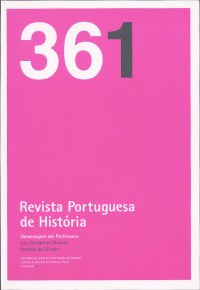Please use this identifier to cite or link to this item:
https://hdl.handle.net/10316.2/46102| DC Field | Value | Language |
|---|---|---|
| dc.contributor.author | Gonçalves, Iria | - |
| dc.date.accessioned | 2019-03-27T11:05:15Z | |
| dc.date.accessioned | 2020-10-05T05:42:00Z | - |
| dc.date.available | 2019-03-27T11:05:15Z | |
| dc.date.available | 2020-10-05T05:42:00Z | - |
| dc.date.issued | 2003 | - |
| dc.identifier.issn | 0870-4147 | - |
| dc.identifier.uri | https://hdl.handle.net/10316.2/46102 | - |
| dc.description.abstract | Quando, nos primeiros anos do século XVI, a Ordem de Cristo decidiu inventariar todas as suas propriedades, deixou-nos uma documentação muito rica e variada, capaz de proporcionar interessantíssimas informações sobre as gentes que exploravam as suas terras. Na aldeia de Puços (actualmente concelho de Alvaiázere) mostrou-nos uma comunidade de camponeses pobres que agricultavam explorações em regra muito pequenas, onde produziam os cereais num sistema de afolhamento bienal, o vinho em pequeníssimas leiras, a árvore de fruto, esta bem representada, tanto pela variedade das suas espécies como pelo volumoso número de indivíduos aí existentes. Para lá das fruteiras, as essências florestais encontravam-se também por todo o lado, a fazer parte de cada uma das explorações agrícolas. Representadas por carvalhos e sobreiros, a formar matas de frutos e rama. Sobre o produto do seu trabalho o camponês via serem efectuadas diversas punções, a contemplar diferentes senhores. Assim, o agricultor podia apenas consumir uma parte bem diminuída da sua colheita, sobretudo a do cereal, até porque não podia esquecer-se de reservar uma parte importante para a sementeira do ano seguinte, sob pena de não poder alimentar a família. | por |
| dc.description.abstract | When the Order of Christ decided to make an inventory of all its properties, in the first years of the 16th century, it left us a very rich and manifold set of documents, able to provide the most interesting information about the people who tilled its lands. In the village of Puços (nowadays belonging to the district of Alvaiázere) this set of records allowed us to find a community of poor peasants who tilled parcels, generally very small, where they grew grains (in a system of biannual crop rotation), wine (in very tiny plots), and fruit trees, these very well represented, as much for their variety as for the large number of inhabitants living there. Beyond the orchards, wood species could be seen everywhere as an extension of each of these parcels, consisting of oaks and cork-trees forming forests of fruit and foliage. The peasants knew that, from the product of their labour, a substantial quota would be subtracted to satisfy several landlords. They would thus consume just a small portion of their crops, particularly of the grain they collected, since they couldn’t forget to put aside the necessary amount to sow in the following year; otherwise they risked no to be able to feed their families. | eng |
| dc.language.iso | por | - |
| dc.publisher | Imprensa da Universidade de Coimbra | - |
| dc.rights | open access | - |
| dc.title | Uma aldeia de finais da Idade Média, nas suas explorações agrícolas: (Puços - Comenda da Ordem de Cristo) | por |
| dc.type | article | - |
| uc.publication.collection | Revista Portuguesa de História nº 36 vol. 1 | - |
| uc.publication.firstPage | 201 | - |
| uc.publication.issue | 36 | - |
| uc.publication.lastPage | 227 | - |
| uc.publication.location | Coimbra | - |
| uc.publication.journalTitle | Revista Portuguesa de História | - |
| uc.publication.volume | 1 | por |
| dc.identifier.doi | 10.14195/0870-4147_36-1_8 | - |
| uc.publication.orderno | 11 | - |
| uc.publication.area | Artes e Humanidades | - |
| uc.publication.manifest | https://dl.uc.pt/json/iiif/10316.2/46102/271212/manifest?manifest=/json/iiif/10316.2/46102/271212/manifest | - |
| uc.publication.thumbnail | https://dl.uc.pt/retrieve/12208350 | - |
| item.grantfulltext | open | - |
| item.fulltext | With Fulltext | - |
| Appears in Collections: | Revista Portuguesa de História | |
Files in This Item:
| File | Description | Size | Format | |
|---|---|---|---|---|
| uma_aldeia_de_finais_da_idade_media.pdf | 636.45 kB | Adobe PDF |  |
Items in DSpace are protected by copyright, with all rights reserved, unless otherwise indicated.
